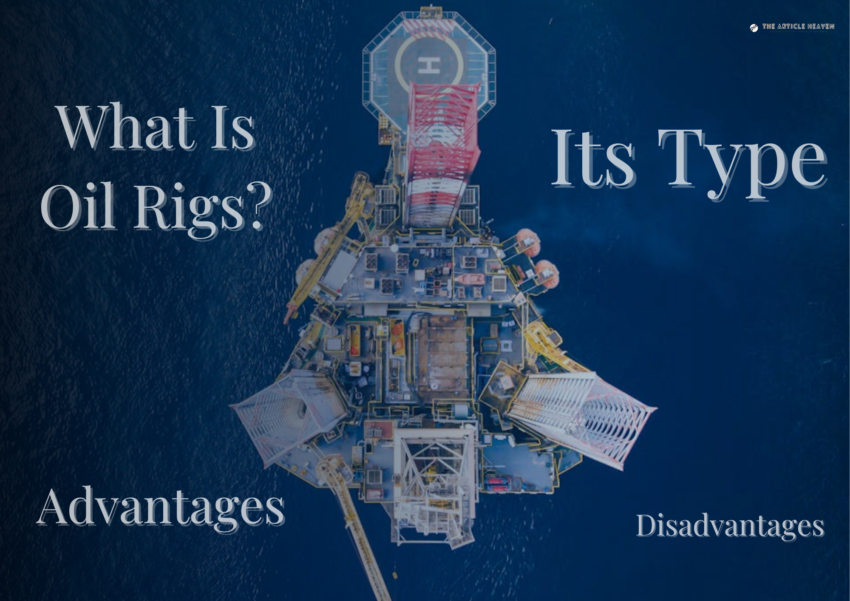An Oil Rig is a giant machine that drills deep into the ground to suck up oil. There are onshore and offshore oil rigs. An oil rig may be an enormous, complicated structure drilling miles into the earth for oil. Some semi-permanent oil rigs provide living quarters for their employees.
In the article of The Article Heaven we read about deeply all the details about oil rigs its advantages its disadvantages and its types. Operating an oil rig requires several processes, including exploration, drilling, extraction, and transportation. Companies use a range of instruments and techniques to make the extraction process safe and efficient. The importance of oil rigs in the energy supply system is, therefore, not debatable.
Also Read: How Oil Rigs Works Majorly?
Types of Oil Rigs
There are many different Types Of Oil Rigs, and each is made for a particular set of circumstances. Below is a summary of the primary types:
- Jack-up rigs: They are portable platforms that may be moved to different places. To raise the platform over the water, they arrange themselves and then low their legs to the platform’s bottom. Jack-up rigs are frequently employed for short-term drilling operations, especially in shallow seas.
- Semi-submersible rigs: Float on the surface of the water and stay afloat even when moored down to the bottom once they have settled. Being stabilized by design even in the roughest environments, semi-submersible rigs are perfect for drilling deeper into water bodies. More often than not, they are applied both to exploratory and production drilling operations.
- Drill ships: Specially designed and equipped ships with drilling equipment on board. Such vessels are perfectly adapted to deep water because of their superior mobility and flexibility. Modern technology makes it possible for these ships to carry out high-precision drilling operations. A fixed platform is a permanent construction mounted on the seabed that can be operational for extended periods. Such structures are ideal for continuous oil production since they can carry out large machinery and laborers.
- Tension Leg Platforms: The structure has vertical tendons attached on the ocean floor on which they float. This form of platform provides them the stability needed to work within the very deep waters. The best installation for the drilling process within offshore conditions is found within tension leg platforms at deep oil fields.
Advantages of an Oil Rig
- Higher production of crude oil: States would lose an enormous percentage of their oil producing blend which is coming from the deep ocean exploration and production if the land-based exploration and production would be solely applied. OCS is one of the excellent examples wherein almost a sixth of domestic oil in the United States is being sourced from a particular location along its coast. The more natural gas and crude oil is produced, the higher it will bring economic efficiency. More than this, it makes the country more self-sufficient and less dependent on other countries.
- Ecosystems: It is well known that Oil Drilling has adverse effects on the environment. Even though the poor management of rigs, inappropriate drilling techniques, and careless material management could have an adverse effect on the environment, there are indications that offshore rigs may foster the development of micro ecosystems.
- Technical Advances: The primary motive for the advancement of technical is oil. Other than improving the productivity and safety of operation, technical improvements in drilling equipment and methods may contribute to other sectors positively.
- Supporting ancillary sectors: The oil and gas industry supports various ancillary sectors, like manufacturing, retail, and transportation. This interlinkage enhances general economic growth.
- Job Creation: Oil and gas jobs are versatile as they include engineers, geologists, but also rig workers and support staff. It offers jobs to local economies.
Also Read: 7 Points For The Importance Of Oil Rigs
Disadvantages of an Oil Rig
- Impact on Environment: Oil Rigs does present some environmental issues. These may be due to the materials used in drilling operations and the hydrocarbons produced during extraction. There have been reports that oil spills have seriously damaged the surrounding wildlife and plants.
- Risk to property and life: Offshore and onshore oil rigs are dangerous to nature. The resources available, the complex processes needed, and the fact that emergency, medical, and safety aid from land can occasionally be far away all contribute to the heightened danger.
- Natural Resources: Oil is a non-renewable resource. Once the reserves are depleted, long-term sustainability of the oil rigs is questioned. It raises questions about whether there is a need for alternatives and whether energy security will be ensured in the future.
- Social Conflicts: Especially in areas inhabited by indigenous people, extraction of oil can lead to disputes over land and resources. Operations can become difficult because of disputes between governments, businesses, and local populations.
